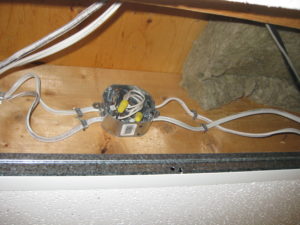DIY Electrical Projects
Many home owners like to install electrical equipment and wiring. As a Professional Home Inspector I would like to list some of the common mistakes that I encounter when inspecting homes in the Barrie ON area. Note: Although a home owner is allowed to install his own electrical wiring, they are required to take out a permit and have installation inspected by the ESA.
Many home owners use metal stud walls in basements, which require special grommets or standoffs when installing electrical cables. Metal studs on basement exterior walls is not a good ideas as metal conducts heat and cold extremely well and can also cause moisture issues due to humidity in air contacting cold areas created by conduction of cold through metal studs.
Most custom builders will use the mould proof treated wood studs when framing in basements. Pressure treated lumber is recommended for sill plate with a moisture barrier between concrete and wood required by building code.
Junction Boxes
Ontario codes 12-3016(1) and 12-112(3) specify that all junction boxes must remain accessible. Junction boxes also require a cover plate to be installed.
Kitchen Installations
Kitchens require at least 2 15 amp multi-wire (split receptacles) or 20 Amp (T Slot receptacles) branch circuits to supply receptacles located along the kitchen counter work surface.
210.52(B)(1)
(1) Wall Counter top Spaces. A receptacle outlet shall be installed at each wall countertop space that is 300 mm (12 in.) or wider. Receptacle outlets shall be installed so that no point along the wall line is more than 600 mm (24 in.) measured horizontally from a receptacle outlet in
that space.
Exception: Receptacle outlets shall not be required on a wall directly behind a range, counter-mounted cooking unit, or sink in the installation described in Figure 210.52(C)(1).
This also includes the requirement for kitchen islands to have an outlet installed.
Ontario electrical code requires a dedicated electrical outlet to be located behind fridge location. This circuit is allowed to provide power to a clock also.
GFCI ( Ground Fault Circuit Interrupter)
Exterior receptacles within 8ft (2.5m) of finished grade (since 1975).
Bathroom & washroom receptacles (since 1986).
Receptacles within 5ft (1.5m) of all sinks (since 2006).
Hydro massage bathtubs must be GFCI protected.
Spas and hot tubs must be GFCI protected.
Receptacles, equipment, and buildings around pools have numerous requirements.
Metal Stud Wall Installation
The Ontario Electrical Safety Code requires that metal stud partitions be bonded to
ground so that the branch circuit over current device will operate in the event the studs become energized.
Securing Cable at Boxes
The electrical cable is required to be secured within 8” to 12” of box with a wire staple. Also you must have a 12” loop of unbroken cable on the outside of box or 6” of cable end available on the interior side of finished wall to permit replacement without major reconstruction.
Extension Cords
Flexible extension cords must never take the place of permanent wiring; they are not designed or intended for permanent installations. Once the task has been completed, the cord should always be disconnected and properly stored away for future use.
Protection of Electrical Cables
Electrical cable should be protected against mechanical damage where it passes through floors or on the surface of walls in exposed locations under 5 feet from the floor.
If burying an electrical cable you should call the ESA and find out the exact requirements for your particular location. The area where cable is buried determines depth and protection required
Dedicated Circuits
These are some of the most common items that require a dedicated electrical circuit for:
Fridge
Range or stove
Cook top
Water Heater
Heat/Air Conditioning
Dishwasher
Clothes Washer
Clothes Dryer
Furnace
Exterior lights and Outlets
Renovations without a Building Permit
The major concern when performing a home inspection and these deficiencies are noted is the fact that you now know that the work was done without a permit and that would most likely apply to all the work done by homeowner.
Why some Homeowners are using Fake Grass
Rules for Secondary Suites in Barrie
Why You Need a Home Inspection
As always, CAVEAT EMPTOR – BUYER BEWARE
An Educated Consumer is a Smart Consumer

